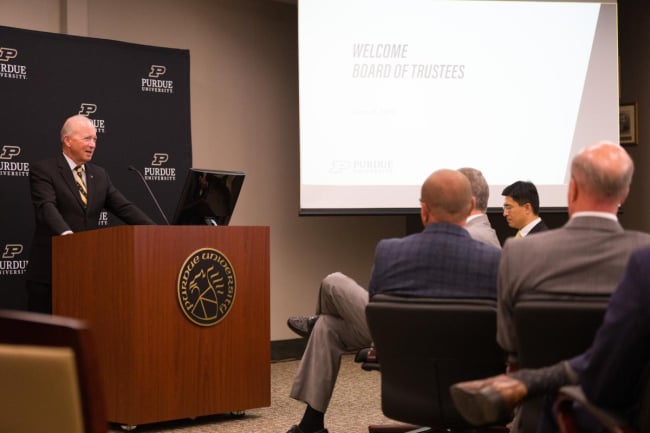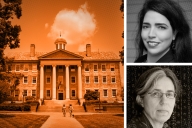You have /5 articles left.
Sign up for a free account or log in.

Current president Mitch Daniels speaks at Friday’s Board of Trustees meeting where Mung Chiang was formally announced as Purdue’s new president.
Purdue University
Friday’s announcement of a new president at Purdue University came as a shock to faculty members caught off guard by the transition. Now they’re charging Purdue with conducting a secret presidential search that has called into question the administration’s commitment to transparency.
While faculty members acknowledge that new president Mung Chiang—currently the dean of Purdue’s College of Engineering—has impressive credentials, they accuse the Board of Trustees and outgoing president Mitch Daniels of eroding the norms of shared university governance by bypassing an open search process. They also note that Purdue officials have offered little explanation as to why the university went with a secretive presidential selection process, a move they feel is unbefitting of a public institution.
Chiang is set to begin on Jan. 1 after Daniels officially steps down.
The Hiring Process
Purdue remains tight-lipped on the matter, revealing few specifics about why it chose a secret search. But one thing that seems clear from university statements is that administrators have had their eye on Chiang for a while.
Tim Doty, a spokesperson for Purdue, said by email that trustees “had been closely watching the performance and readiness of Dean Chiang for several years—in a role that was intentionally expanded over that period to test his leadership abilities in a variety of dimensions. Chairman [Michael] Berghoff made clear the board would have conducted a formal search process if it had been less than fully confident Dr. Chiang was uniquely qualified to lead Purdue into the future.”
While the search may have riled transparency advocates, it falls within Indiana law.
“Indiana law gives the Purdue Board of Trustees the authority and responsibility for electing the president of the university. Board deliberations in previous presidential selection processes at Purdue have been conducted in executive sessions, which are not open to the public. This is both customary and permitted in Indiana,” Doty explained in the email to Inside Higher Ed.
Chiang, who spent 14 years in various roles at Princeton University, has been at Purdue for five years. In April 2021 he was promoted to executive vice president for strategic initiatives, a move designed to evaluate Chiang’s leadership abilities, according to Purdue’s statement.
While the timeline for the search is unclear, Daniels indicated “sometime last year” that he was interested in concluding his term soon, Berghoff said at Friday’s Board of Trustees meeting, where the presidential transition was announced. But according to Berghoff, Daniels officially decided to retire in April.
“In April, following our board meeting, he informed the board that his decision was to retire at the end of this year. That’s when we decided to make a verbal election, if you will, to Dean Mung,” Berghoff said Friday.
At Friday’s meeting, Daniels said that it would be hard to find another Board of Trustees that has approached a presidential search “more thoroughly, carefully, thoughtfully and methodically than this one did,” noting they were ready to look elsewhere if they didn’t identify the ideal candidate.
But Purdue has yet to reveal many details about the search, including the number of internal candidates considered, a question Inside Higher Ed asked but received no answer to.
Daniels also said Chiang’s role at Purdue was intentionally expanded, indicating that Chiang was under consideration for the job well before Daniels formally told the board in April that he planned to retire. Notably, Chiang, an early front-runner in the recent University of South Carolina presidential search, cited responsibilities to his family and to Purdue when he dropped out in December.
Leigh Raymond, a professor of political science at Purdue and president of the Purdue–West Lafayette chapter of the American Association of University Professors, noted that the April-to-June timeline would make for a short search. He suspects Chiang was identified previously as Daniels’s successor—perhaps even handpicked by Daniels to step into the presidential role.
Raymond also charged Daniels and an “activist” Board of Trustees with eroding shared governance in a decision that will undermine Chiang’s legitimacy as Purdue’s president.
“Many of us, certainly myself, we don’t know the new president. He’s the dean of engineering. He’s clearly a very successful academic—that’s important. But we’ve been denied the opportunity to even get to know him or even hear from him, what his vision is for Purdue, going forward,” Raymond said.
Raymond and other AAUP members said they wanted an open search with faculty input, and they see the absence of such a process as an attack on the principles of shared governance. Raymond said he was “astonished” and “in a state of disbelief” when the hire was announced last week. The issue for faculty, he emphasizes, is not with Chiang but with the exclusionary hiring process.
“It feels obvious to me that if you’re going to make the choice of a new leader for a major public university, you would want to get input from the faculty or the people who really make the university operate, people at the heart of the university. The lack of an inclusive process where faculty could provide input is really alarming,” Raymond said. “Without even getting into the issues confronting Purdue right now, choosing a new leader is not something that happens every day. And the entire campus community should have an opportunity to help the board understand what the issues are that we see as being important for the university going forward.”
Other AAUP members echoed Raymond’s thoughts, accusing Daniels and the Board of Trustees of bypassing faculty input in past years and unilaterally imposing impactful decisions on the university.
David Detmer, president of the Purdue Northwest chapter, said that a lack of faculty consultation in important decisions has been a disturbing pattern in Daniels’s time as president.
“In 2014, President Daniels and the Board of Trustees ordered two Purdue universities—Purdue University Calumet and Purdue University North Central—to merge. When the Faculty Senate at Purdue Calumet passed a resolution calling for more study before taking this critical decision, this faculty recommendation was rejected,” Detmer said in an AAUP Purdue statement.
Beyond Purdue’s campus, the national AAUP has also condemned the lack of transparency in the search.
“The AAUP is disturbed by the news that the next president of Purdue University has been selected unilaterally by the Purdue University Board of Trustees, following a closed and unannounced process. The hiring was announced on Friday, June 10, as a fait accompli, with no participation by representatives of the faculty or other campus constituencies,” the AAUP statement read in part.
Additionally, the organization noted that a 2021 AAUP survey “found that all but 5.6 percent of doctoral institutions had involved the faculty in their most recent presidential search.”
The Daniels Search
Daniels is set to retire from Purdue after a 10-year run. He joined the university in 2013, fresh off a two-term stint as Republican governor of Indiana. His legacy, which includes freezing tuition for a decade and rapidly expanding Purdue’s online offerings by purchasing the for-profit Kaplan University, has been both praised and scorned.
Critics of Daniels noted that he was hired in a more transparent—but still imperfect—process. Though the Board conducted an open search 10 years ago, Daniels, as governor, had appointed some of the trustees who ended up pushing for his hire as president.
“The search that resulted in President Daniels was still at least a public search with a publicly announced search committee, although the selection of Daniels was largely imposed by the board on the search committee. I think the board was pretty clear that if then governor Daniels was interested or willing to consider the job, he was their first choice. That was not an ideal process in terms of transparency, but at least there was a process, a search committee, and there was a sense that there was a public discussion at the university level about what we were looking for in a new president,” Raymond said. “This is just another dramatic step in the wrong direction.”








